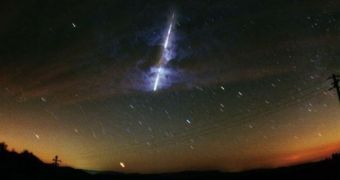Almost a decade ago, we were accustomed to seeing strong meteor showers sported by the Leonids. They were really impressive back then, but of late they have reduced in size, rate and awesomeness, with a small exception provided this year, when the fireball display took astronomers by surprise. Still, it's hardly comparable to those in 1999 or 2001. Nevertheless, based on recent observations and calculations, astronomers preview a somewhat more intense show for the next November.
The experts from the California Institute of Technology (Caltech) and from NASA have managed to extrapolate on this year’s Leonids manifestations and determine how those of 2009 will be. According to their results, if the fireballs of November 17th 2008 are only able to provide a rate of 100 meteors per hour, the same date in 2009 will see its rate increased by a factor of five. This could mean one "falling star" every approximately seven seconds.
"On Nov. 17, 2009, we expect the Leonids to produce upwards of 500 meteors per hour," shared Bill Cooke from the NASA Marshall Space Flight Center, cited by Space. "That's a very strong display," stated the scientist, adding that "We predict a sub-storm level outburst on Nov. 17, 2009, peaking sometime between 21:34 and 21:44 UT". The term "storm" refers to a rate that exceeds an amount of 1,000 fireballs per hour.
Leonids are caused by our planet crossing the several streams of debris fragments drifting through the solar system, which were left behind by the comet 55P/Tempel-Tuttle during its repeated passings through this region. The stream encountered this year formed in 1466 AD, and next year we will pass closer to its center, where the material is denser and will produce a more complex light show, best viewable from Asia, but possibly also from North America. "I hope so," said Cooke. "It's a long way to Mongolia."

 14 DAY TRIAL //
14 DAY TRIAL //